 |
|||||||||||
Opus 378 (completed on April 24, 2018). This posting was intended to take place about a week ago as a supplement to Opus 377, which we mercifully shortened by leaving out our customary review of editoons. But before we could post it, we were overtaken by Breaking Nous, which, duty-bound, we’re compelled to post—namely, this year’s Pulitzer Prize fiasco (for a graphic novel?!), the New York Times report on Stan Lee, the memorable debut of the new (West Coast) Mad, and a report on our adventures at DiNK, the boutique comic-con in Denver. Getting all that done took a few more days than we’d anticipated. But it’s done at last. Here’s what’s here, in order, by department—:
NOUS R US The Pulitzer Fiasco A DiNK Weekend: New Kind of Comic-con New York Times to the Rescue of Stan Lee Surprise: A New Mad, Starting at No.1
ODDS & ADDENDA No “Marvel” at Disney Adventure Land Saudi Arabia Opens Movie Theaters Action Comics No.1000 “Challenged” Books in 2017
EDITOONERY An Extensive Review of the Month’s Editorial Cartoons
QUOTE OF THE MONTH If Not of A Lifetime “Goddamn it, you’ve got to be kind.”—Kurt Vonnegut
Our Motto: It takes all kinds. Live and let live. Wear glasses if you need ’em. But it’s hard to live by this axiom in the Age of Tea Baggers, so we’ve added another motto:. Seven days without comics makes one weak. (You can’t have too many mottos.)
And our customary reminder: don’t forget to activate the “Bathroom Button” by clicking on the “print friendly version” so you can print off a copy of just this installment for reading later, at your leisure while enthroned. Without further adieu, then, here we go—:
NOUS R US Some of All the News That Gives Us Fits
THE PULITZER FARCE The Pulitzer Prize for editorial cartooning has finally resolved itself into the farce that many have always thought it to be. This year’s Prize went to two people who collaborated in producing a graphic novel that ran serially in 19 installments in the New York Times. A graphic novel is not a cartoon. Compounding the sham, one of the collaborators is the writer; the other, the artist. Neither is a cartoonist. So this year’s Pulitzer Prize for editorial cartooning went to a non-cartoon produced by non-cartoonists. To compete for the Pulitzer, cartoonists nominate themselves by submitting a portfolio of what they regard as their best cartoons of the year. Sometimes their newspapers submit the portfolio, as I suspect happened this year with the New York Times. Three times before in the history of the Pulitzer for editorial cartooning the prize was awarded to people working in realms outside the editoon arena. Gary Trudeau won in 1975 for Doonesbury, a comic strip not the single-panel cartoon format of time-honored custom; and in 1987, Berk Breathed won for Bloom County, another comic strip. Then in 2010, Mark Fiore, a self-syndicated editoonist, won with a portfolio of animated editorial cartoons. But all three of these practitioners in non-traditional modes were cartoonists. Only the New York Times would think of submitting a non-cartoon in the category of editorial cartooning: the paper has notoriously not had an editoonist on staff in living memory, suggesting the disdain in which traditional editorial cartooning is held at the nation’s “paper of record.” The mold-shattering in this year’s award was even more extensive: never in the history of the editorial cartoon prize, beginning in 1922 with the award to Rollin Kirby, has it been awarded to more than one person for a single entry. The
two freelancers, not New York Times staff members, who produced this
year’s winning Welcome to the New World are writer Jake Halpern and
artist Michael Sloan. In an introduction to the series, Halpern wrote that Welcome to the New World reports the stories of two Syrians, brothers Jamil and Ammar, who “fled Syria in 2012, with their wives and children. After four years waiting in Jordan, they finally received a visa and traveled to the United States as refugees,” arriving on November 8, 2016. The tale continues with an account of the families’ lives in America. In announcing the award, the Pulitzer people described it as “an emotionally powerful series, told in graphic narrative form, that chronicled the daily struggles of a real-life family of refugees and its fear of deportation.” The series “provided a vivid and frequently harrowing depiction of the modern refugee experience in the United States. The episodes were based on months of interviews and reporting, but Halpern suggested that some of its most powerful moments were frames [panels, i.e., pictures] that contained no words at all.” In short, Welcome, while not an editorial cartoon, is a visual enterprise, like an editorial cartoon, that deals with current events and undoubtedly expresses the creators’ opinion about those events. With this gloss, it sneaks into qualification as an editorial cartoon. But the Pulitzer’s criteria are so general that almost anything qualifies. The Prize is given “for a distinguished cartoon or portfolio of cartoons, characterized by originality, editorial effectiveness, quality of drawing and pictorial effect, published as a still drawing, animation or both.” Nothing here about expressing opinion on current events or how effective visuals are used to express the opinion or how vividly that expression might be although I suppose “pictorial effect” might include those concerns. An award with the prestige of the Pulitzer should surely more insightfully describe what qualifies as superior achievement in the medium. But the Pulitzer doesn’t go that far. In reporting the award of this year’s Pulitzer for editooning, Michael Cavna of the Washington Post’s Comic Riffs noted that this year’s selection signaled “a potentially seismic shift in the category going forward.” Suspiciously, the Pulitzer announcement did not name the jurors on the committee that made the choice. The jurors usually include at least one editorial cartoonist, sometimes last year’s winner (who was Jim Morin). Maybe the cartoonist juror(s) this year thought their choice was risky and preferred not to endure any post-choice brickbats. Unquestionably, the choice of the winner this year responds to the changing landscape in political cartooning. The number of full-time staff editoonists has been steadily declining since May 2008 from about 101 to today’s 50 or slightly fewer. As journalism shifts from paper and ink to electronic digits, editorial cartooning must adjust—or continue to slowly expire. When the Pulitzer went to Fiore in 2010 for animated editorial cartooning, it signaled a change in the Pulitzer definition of editooning, and the change accommodated an emerging aspect of the medium. Many editorial cartoonists to whom Cavna talked applaud this year’s latest broadening of what editorial cartooning is. “I have to say this year’s [prize] was a surprise,” says Matt Wuerker, the Pulitzer-winning cartoonist for Politico. “On the positive side, I think it’s great to see the old-fogy prizes evolve and get with the times. The Herblock Prize broadened the category years ago. Awarding the great work being done in comics journalism is a good thing.” Matt Bors, a past Pulitzer finalist and winner of the Herblock Prize for editorial cartooning, strikes a similar tone. “I think broader approaches to comics in journalism being considered for the Pulitzer is a good thing,” says Bors, founder of the comics journalism online site The Nib. “I hope more media outlets will take note of how you can apply nonfiction and satire — and then hire some cartoonists.” Joel Pett, the Pulitzer-winning cartoonist for the Lexington Herald-Leader, echoes that sentiment, saying to Comic Riffs, tongue sarcastically in cheek: “I hope the New York Times will now support even more comics and cartoonists.” And Jack Ohman, the Pulitzer-winning cartoonist for the Sacramento Bee, cheers what this year’s winner reflects at large. “It’s a good sign that we don’t get locked into the [lone] rectangle cartoon format that people are familiar with. We’re all trying different things that are vital and cross-platform.” The Association of American Editorial Cartoonists (AAEC) has long been concerned about the slow evaporation of the profession. Pulitzer-winning Ann Telnaes finished her tour as president of the group with this call to action (in the Notebook, 2017 Annual): “For several years now we have complained, bemoaned and raged over the disappearance of our traditional home, the print newspaper. ... The AAEC is also facing the problem of an aging and shrinking membership. Another consequence of the decline of newspapers is that hardly any young editorial cartoonists get their start there [i.e., in newspapers, traditionally college campus newspapers] anymore. The cartoonists today are mostly freelancers and work hard at promoting themselves and their work online and by attending various comic/cartoon festivals and conventions.” I disagree: I suspect that campus newspapers are more alive than dead and that editoonists are as widely published in them as ever. But I have no more evidence for my feeling about this than Telnaes does about hers. Besides, the crisis is fully present regardless of where or how young editoonists get their starts. Or don’t. Telnaes continues: “Why are we at this point? Let’s face it, the AAEC hasn’t come to grips with the changed landscape in the publishing of news. ... We’ve really just skirted around the big issue in the room: how to preserve the editorial cartooning profession in the Internet age. ... “Change is always hard, even when it’s for the best. Editorial cartooning has played an important part in journalism throughout our nation’s history, and I believe will continue to in the future, whatever medium we use—but we need to be proactive. Editorial cartooning is a vital part of political discourse and much needed, especially in today’s political climate. Let’s recognize this and move forward to preserve our profession.” But she has no concrete proposal about how this might be accomplished. It could be that the Pulitzer jurors this year share Telnaes’ alarm and made their choice accordingly. The graphic novel is the most conspicuous advance in recent history of the ways cartooning is done. If the Prize for editorial cartooning went to a graphic novelist, the prestige of the Pulitzer coupled to the growing popularity of the form might be the right move toward revitalizing the profession. And there is no dearth of support for this scheme, if, in fact, the Prize this year was awarded with such an intention in mind.
“AS FAR AS THE DIFFERENT CHOICE for the Pulitzer editorial-cartoon category this year, I’m fine with it,” says Fiore, who was named a Pulitzer finalist this year along with Mike Thompson of the Detroit Free Press, whose work falls into the traditional editoon format. Talking to Cavna, Fiore continued: “I think it’s just fine to expand the category of ‘editorial cartooning.’ Remember,” he went on, “I’m the guy who sent a spite Pulitzer entry for about five consecutive years before they accepted submissions made up of online-only cartoons. “I welcome graphic journalism, comics journalism and even cartoon journalism,” Fiore went on. “Cartoons like these could just as easily fit the explanatory-journalism category or maybe even nonfiction” in the literature category.” Fiore’s description of the fluidity of Pulitzer categorization leads to a strong counterpoint, Cavna observes: some cartoonists say they object to how the Pulitzer jurors might effectively redefine the traditional term “editorial cartooning.” “While I think the work was worthy of a Pulitzer,” cartoonist Wiley Miller says of Welcome to the New World, “it was not worthy of this particular prize, as it’s neither a cartoon nor an editorial. It’s graphic journalism, and there should be a category for that, as it’s a growing new field,” continued the Reuben Award-winning creator of the syndicated strip Non Sequitur and a former staff editoonist. Miller says freelancer Brian Fies is one the best currently working in this form. But Miller also contends that neither winner of this year’s award was functioning as a “cartoonist”: “One [Halpern] is a writer and the other [Sloan] is an illustrator. A cartoonist is one who [both] writes and draws their own material.” Politico’s Wuerker has a different criticism of this year’s win: should the award go to work that is only tangentially connected to President Trump? “Seeing as we’re living through one of the wildest and most unruly periods in American politics, it’s truly strange for the Pulitzers to not fete the bare-knuckled, unruly end of the cartoon spectrum,” Wuerker said to Cavna. “The cartoons being cranked by today’s editorial cartoonists are as good, tough and spot-on as the work that was being done in other earlier golden ages for political satire — such as the Vietnam-Watergate era, or before that, the cartoons created during the Gilded Age.” He continued: “If our roiled political waters ever calm down, then sure, it’s great to recognize new, softer forms of cartooning. But it seems in these political times, the Pulitzers really should have gone with something political. In the time of Trump, how can the editorial-cartoon prize not go to the best Trump cartoons?”
HOW? ASK PAT OLIPHANT, perhaps the most highly regarded editorial cartoonist in the 60 years. In 1987, following Pulitzer’s awarding the Prize for editorial cartooning to Berk Breathed, Oliphant weighed in: “This year, Bloom County,” he roared. “Next year, Garfield.” And in Target (The Political Cartoon Quarterly) for Summer 1987, he went on at great length in paragraphs of indictment and ridicule that could well apply to this year’s hoax—: “The Pulitzer Board by their action has complete debased the prestige of the award that symbolized for years the best that graphic commentary, opinion, and political information had to offer. It was a slap in the face to the legacy of dedicated opinion sharpers who have previously won the award—Herblock, Conrad, Mauldin, Fischetti, Auth, MacNelly. And I could go on. ... “For the Pulitzer writing awards, there are a great many categories and thousands of eager petitioners, so Pulitzer can give a few bows to some extraordinary efforts by small enterprising newspapers or writers. [Why not, then, have more than one cartooning category?] They then swap the other remaining awards around among themselves. This works with some degree of legitimacy because there are so many writers in the country, literally tens of thousands, so the coziness has cover. “But the ‘dealing among the biggies’ formula breaks down when it comes to editorial cartooning where large numbers can no longer provide a cover. We are few. And it gets a bit embarrassing to have to give the same award to the same cartoonists two or three times. ...” The Pultizer for editorial cartooning has been awarded 91 times since the first in 1922; in 5 years, there was no award. Of the 91, 15 awards were apportioned among 5 cartoonists, each of whom won 3 times; that’s 16% of the awards given. Another 18 cartoonists won twice each, 36 awards; that’s 40% of the total awards. Together, the two-time winners and the three-time winners represent 56% of the awards given. Yes, embarrassing. It’s tacit admission that there aren’t enough editoonists to justify an award. So, Oliphant continued, the Pulitzers decided in 1987 to widen the field and conceal the revealing paucity of candidates by awarding the Prize to a comic strip cartoonist, immediately thereby creating more than 200 possibilities for future awards. “No longer an award for editorial cartoonists. The Pulitzer board now gives an award for cartoonists!” Oliphant recognized the dilemma the profession faces even today. “True and effective, hard-hitting, junk-yard dog political cartoonists are a rare bred and about to get even more rare if current trends continue.” As you can tell, Oliphant was no fan of the Pulitzer. He won the Prize once, in 1966 during the Vietnam War, and he did it to make a point. In Columbia Journalism Review (Spring 2016), Telnaes tells the tale—: “As he tells it, Oliphant wanted to make a point about how the Pulitzer board’s hoices in the cartoon category were more about personal politics than identifying exemplary work in the field. “He
looked back at previous winners and, base upon what he saw, chose from his work
a submission he thought would suit the judge’s tastes and the prevailing
political opinion at the time [during the Vietnam War]. He says now that his
cartoon was ‘one of the worst cartoons I’ve ever drawn.’ [Which we’ve posted
near here with another, somewhat harder-hitting junk-yard dog opinionated and
therefore possibly offensive cartoon of Oliphant’s that he once described as
his favorite.] Oliphant’s submission “depicted the president of North Vietnam, Ho Chi Minh, holding a dead Vietnamesse with the caption ‘They won’t get us to the conference table ... will they?’ “Well, guess what. That cartoon did in fact win. (Back then, it was common to give the award for a single cartoon rather than a body of work.)” Oliphant’s cynical expose demonstrated the fallacy in the Pulitzer farce. Looking over the previous winners, he saw that the Pulitzer judges seemed to favor sentimental slop rather than rigorously stated possibly offensive opinion. In choosing the cartoon he submitted, he effectively predicted how the judges would vote. Sentiment, he determined, was more important to the Pulitzer judges than provoking thought about or debate on public issues. And that may well describe this year’s winning “cartoon.” I haven’t seen it, but even the short description of its content suggests that the story it tells is a hard-luck story, probably one that has a happy ending. The story is undoubtedly heart-felt. Clearly, the editors of the New York Times thought Welcome would make a case for humane treatment of immigrants in our troubled world. Whatever is virtues in the public square, Welcome is not a cartoon, and it wasn’t produced by a cartoonist working on a daily deadline. It should not have won. After winning, predictably, the Pulitzer in 1966, Oliphant’s subsequent action—inaction, rather—was to never again enter his work and “to use his status as a past winner to criticize the Pulitzer selection process well into the future.” And his criticism of the Breathed win in 1987 is a healthy sample of the kind of criticism he’s been making ever since.
THIS YEAR’S AWARD, deliberately widening the field of possible candidates, lumps all cartooning into one competition. As Oliphant suggested, there should be more than one category for cartooning. This year’s winner and a growing interest in cartoon journalism suggests the obvious new division—cartoon journalism. And there’s already been an exemplary winner in that category, albeit without the existence of the category. The only cartoonist to previously win a Pulitzer Prize for long-form reportorial comics is Art Spiegelman, Cavna reminds us, whose groundbreaking Holocaust epic Maus received a 1992 “special citation” from the Pulitzers, a cobbled-up category that signaled the deficiency in the Pulitzer categories. It was a category, Spiegelman quipped, that is “designed to honor anomalous creators like E.B. White, Duke Ellington, Bob Dylan and Dr. Seuss.” “Another award in my medium has seemed long, long overdue,” Spiegelman said.“The Pulitzer committee has honorably grappled with how to recognize a medium that has newsprint in its DNA.” He sees the recognition of Welcome to the New World as a tribute to the “avalanche of jaw-droppingly significant achievements in comics over the past decade or so, as it continues to flourish.” One of the profession’s habitual critics, Ted Rall, thinks otherwise. “They didn't post who was on the committee so it's hard to know why they made the decision they did,” he said on e-mail. “This feels like the latest in a long line of middlebrow judging decisions: not much thought went into it, the work was inoffensive and somewhat generic, the subject was unimpeachable and the venue was Serious (that's where the New York Times thing comes in). The same piece in the Akron Beacon-Journal or HuffPo probably would not have received serious consideration. “Personally,” he continued, “my gripe is that the award was shared by a writer and an illustrator. In other words, two non-cartoonists won the cartooning category. “Bottom line,” he finished, “this was not the best cartooning published in the United States in 2017. Not even close.” Another editoonist, Mike Keefe of the Denver Post, also faults the Pulitzer Prize—and many of the other editoonery competitions. “We take these things seriously,” he said in Target (The Political Cartoon Quarterly), Spring 1983, “—even though we suspect the selection of a winner is about as thoughtful as drawing the grand prize stub in the state lottery. Among the problems, the constitution of the judging panel: “Most panels consist of newspaper editors. If I had to choose a class of professionals to judge editorial cartoons, I’d choose orthodontists over editors. Most editors are principled journalists. Among their tenets are fairness and objectivity. Some of the most effective (as well as some of the least effective) cartoons violate these canons. ... How often does a panel of judges include a respected art critic? Why not include someone in an unrelated profession who deals with many of the same elements used by a cartoonist? ... a film maker, a visual artist who attempts to make a point through humor or pathos. “Another problem: which is better—to fashion a new and insightful metaphor for the economic travails of Abu Dihabi or to get a crooked city council man canned because of a pointed cartoon? Take a guess which one has the best chance of winning an award. At the community level, the cartoonists is in the trenches. He has the potential to lob grenades, alter the landscape, capture ground. At the national and international level, he’s merely pushing toy soldiers around, having little or no affect on the real battles. It’s about time the guy with mud on his boots got a ribbon for his efforts.” “The awards system is flawed,” Keefe concludes. “Almost everyone agrees. ... In spite of it all, I’ll continue to enter them for the same reason you will—maybe this year, I’ll get lucky.” Eight years later, Keefe got lucky and won the Pulitzer. But the profession at large has not been so lucky. It is slowly disintegrating And to rub salt in the wound, the most prestigious of the awards given its practitioners scarcely applies to the kind of work they do. The Pulitzers need to include in the qualifying criteria for its award in editorial cartooning the necessity for expressing opinion on current events, and the winning cartoon must demonstrate how effective visuals are used to express the opinion and how vividly that expression might be. And then the Pulitzers should add another category—cartoon journalism.
A DiNK WEEKEND Your Rancid Raves reporter spent April 14-15 at the third annual Denver Independent Comic Art Expo, or DiNK, the acronym into which the founders inexplicably conflate the name. Co-founded by Denver’s Charlie La Greca, Jeff La Greca, Dan Crosier and Jim Norris with the able operational labors of Bonnie Graham. DiNK studiously avoids the trappings of the big comic-cons—no celebrity appearances, no Hollywood stars, no animation voice-overers, no video games or cosplay contests (well, one of those, about which, more anon). DiNK proclaims itself a “boutique comic-con.” Various corners of it have a distinctly “hippie” flavor, and the clientele is extensively tattooed. One of the items in the goodies packet distributed at check-in was a booklet entitled S.T.A.T.S., which stands for Sight, Touch, Aroma, Taste and Sensation—a “Guide to Evaluating the Essential Aspects of Cannabis.” A preliminary tally showed a substantial increase in attendance—just a couple dozen shy of 3,000. The aisles teemed with people, all smiling happily. “Fantastic growth this year,” Charlie told me. “And I can't tell you how much all the amazing comments and positive feedback on the show mean. Together—we are all creating a true comic art show and it feels GREAT!” Charlie and Frank, who also co-founded the Denver Comic-Con, have focused on the comic book as produced by small, independent operators and on the arts and crafts associated with that kind of production. F’instance—: Wandering the aisles between display tables, I saw an energetically rendered series of comic books written, drawn and produced by Gideon Kendall— Whatzit, Nos.1-5 (so far). His artwork is so dazzlingly expert that I wondered what he did when he wasn’t doing his own limited press-run comic books. Why, in other words, wasn’t he doing Marvel or DC comic books, which is where I’d expect to find a comics artist of his skill. His answer: well, not yet. He’s hopeful. Meanwhile, he keeps busy. Working out of Brooklyn, he does a lot of freelance comics work, he told me, and children’s book illustration and comically weird sf pictures, but his most rewarding financially is designing animation for children’s tv shows, which he does freelance, like everything else. For samples of the array of his talent, visit gideonkendall.com. What may be Kendall’s most ambitious print project lately is Marley’s Ghost, an adaptation of Charles Dickens’ Christmas Carol that was started but never finished by Harvey Kurtzman sometime in the 1950s. Kurtzman laid out and sketched in his customary manner about three dozen pages of a 60-plus page graphic novel. Kendall with writers Josh O’Neill and Shannon Wheeler finished the project, following Kurtzman’s adaptation in layouts and design. It may see print soon, but in the meantime, you can buy the whole thing in digital format from Amazon or comixology.com for five bucks or so. I talked to Denis Kitchen about Marley’s Ghost. He had a table at DiNK, and he has some production connection to the project, deriving, no doubt, from his involvement with the Kurtzman Estate. It was he, I assume, who unearthed the Ghost sketches. He told me that, judging from the condition of Kurtzman’s artwork, his interest in adapting Dickens’ classic seemed to wane the further he got into the story. He was most engaged in the “ghost story” aspect of the tale, apparently; and once he had to contemplate drawing crowd scenes of people in Victorian garb at parties of Christmases past and the like, his enthusiasm flagged. The first 30-40 pages of his breakdowns are classic Kurtzman in format and appearance; after that, as he seemingly lost interest, the breakdowns are more and more sketchy. That’s how the weekend went. But before going on, here are some illustrations showing what Kendall is up to.
DINK took place in the McNicols Center, a cultural edifice in downtown Denver. Named after a mayor of the city, the building was once the city’s public library. Since then, it has been virtually gutted to create a hollow space that can host various kinds of events (those that need exhibit space and don’t object to heating and air-conditioning pipes in the ceilings). DiNK occupied all three floors of the Center with a wide assortment of comic-booky tabletop exhibits (mine among them). At
another table, I saw another pile of attractively drawn comic books—including
Boom’s first two issues of Big Trouble in Little China: Old Man Jack, written
by John Carpenter and Anthony Burch, drawn by Jorge Corona, who was staffing the table. Corona’s line, as you can see nearby, is muscular
and marvelously flexible, waxing thick to show power and force, waning to add
details. I talked with Denis Kitchen for a while. He displayed all his books published over the last 20 years or so, including Underground Classics: The Transformation of Comics into Comix, by Kitchen and James Danky and published by Abrams (2009, 150 9x12-inch pages, hardcover, $29.95)—the only one of his titles that I don’t have. He was promoting a new project, Denis Kitchen’s 3-D Chipboard Portfolio, a collection of ten 3-D prints in large 11x14-inch format with custom blue/red glasses, due in 2017 from Beehive Books. I
told him I’d just finished reading Trina Robbins’ autobiography
(reviewed here last time, Opus 377), and he said he was disappointed in it.
He’d had the project for a while and had urged Trina to included much more of
her cartooning career than she eventually wrote about. She finally took her
book to Fantagraphics. Kitchen
and Howard Cruse did a presentation together on Sunday afternoon, called
“Pioneers of Underground Comix: A Conversation.” After the presentation, I talked with Cruse, who is widely recognized as the cartoonist who pioneered bringing the gay experience to comics. I wanted to know, chiefly, what he was doing these days. I told him I expected that the emergence of GLBTQ into the mainstream would give him lots of publishing opportunities. Not so, he said. He’s not all that busy. But the problem isn’t the gay subject: it’s the disappearance of print as a publishing medium. He still does a little work here and there, he said, but with the slow evaporation of print outlets, he has fewer places to go. Besides, he said, he doesn’t work only with gay topics. (“Queer” is his preferred nomenclature: too hard to say GLBTQ, he said.) I bought two of his books that were on display—and an original Barefootz comic strip. This is a version of Barefootz that he cleaned up somewhat with the hope of getting it syndicated. From the comic books, you’ll doubtless remember Barefootz, an unassuming guy with big bare feet, whose apartment is infected with a congregation of highly verbal and aggressive cockroaches. All drawn in Cruse’s distinctively simple, bold-line style with tones of pointillist precision. Barefootz is one of my favorite comics creations, so I was disappointed when Cruse told me syndicates weren’t interested in distributing the strip. One syndicate, however, said they’d give it serious consideration if Cruse would take the cockroaches out of it. Ha. Talk about bureaucratic obtuseness. I bought two of Cruse’s books: From Headrack to Claude: Collected Gay Comix (2009, 100 8.5x11-inch pages, paperback $19)and The Other Side of Howard Cruse (2012, 230 8.5x11-inch pages, hardcover, $24.99), which included a lot of Barefootz but also a generous sampling of his non-gay (sad?) comics—political satire, his takes on Nancy and Little Lulu, accounts of trips taken and more. Visit his website, howardcruse.com, where there is a treasure trove of Cruse comedic art—including a blow-by-blow (pardon) illustrated discussion of how he developed a 2-page Wendel strip. And hundreds of other hilarious visual treats. His ability to create comedy with playful drawings is, in my experience, nearly unparalleled. The invention on display is wondrous. A few samples of all this are posted near here.
I had a good weekend in sales at my table, but the exciting part was seeing how good so much otherwise unheralded cartooning is. The new talent at the tables overflowed. Kendall and Corona were only two of scores of others, many of whom equaled their skills. Oh—the cosplay contest? It was for dogs, whose owners dressed them up as superheroes. Canine cosplay.
THE TIMES TO THE RESCUE Stan Lee Not a Prisoner in His Own House The august New York Times, newspaper of record, decided, finally, to make a record of what’s going on with Stan Lee. Is he being held captive by unscrupulous “vultures” bent on siphoning his fortune into their pockets? To get an answer, the Times sent a reporter around, and Ben Widdicome reported on April 13, to wit—: “A 6-foot-4 security guard, with a pistol on his hip, opened the front gate. And Lee hasn’t been getting out as much, after a bout of pneumonia that has left him short of breath and looking frail. He also can no longer read because of macular degeneration. “Despite all that, Lee seemed relaxed and enthusiastic. Wearing a yellow shirt and beige polyester slacks in his poolside sitting room, its Sherwood-green carpet bleached by 40 years of California sunshine, he welcomed a reporter into his home.” As we observed last time in Opus 377, when The Hollywood Reporter investigated, it reported that Lee, 95, is the victim of “elder abuse,” partly at the hands of his 67-year-old daughter, Joan Celia Lee. The Daily Beast reported last month that Lee, who is said to be worth around $50 million, was “surrounded by a panoply of Hollywood charlatans and mountebanks” and being “picked apart by vultures.” And “a radio talk show in Orlando, Fla., even aired a rumor that he is being ‘held captive’ by handlers who ‘have him basically locked up in the house.’” Apparently not, saith the Times. “I’m the luckiest guy in the world,” Lee said, chuckling and sounding like a 95-year-old teenager. “Nobody has more freedom.” “He
also defended his daughter, known as JC, against claims that she has been
physically abusive and a financial drain. “My daughter has been a great help to
me,” he said. “Life is pretty good.” Since the death of his beloved wife Joan of 72 years last year, “Lee’s household has been thrown into disarray, with three factions of once-trusted aides vying for control.” Lee got rid of a couple of them, leaving the field to Keya Morgan, “a former memorabilia dealer from New York who moved to Los Angeles as the executive producer of the mobster biopic ‘Gotti,’ and now describes himself as a ‘producing partner of John Travolta.’ Sitting at Lee’s side, he was dressed in a black suit and tie, black bowler hat and dark sunglasses, which he lowered on his nose to see indoors.” If
ever there were a suspicious-looking character, Morgan is it, as you can
doubtless tell from a photo of him with JC that we’ve posted in this vicinity. In February, Widdicombe reports, “Morgan called police to the house to physically remove Lee’s longtime road manager, Mac Anderson, known as Max. Anderson was accused of, among other things, attempting to bribe a nurse to make statements that Lee was being held hostage.” “He got into a big fight with Stan and Stan’s daughter,” and was fired soon afterward, Morgan said. Most of what the Times found out, we recorded in Opus 377. More or less. Minus some of the more colorful language. For instance, Jerry Olivarez, a Hollywood publicist, made off with $300,000 and a $850,000 condo for himself before he was fired. “In unrelated matters,” Widdicombe says, “$1.4 million may have vanished in a series of wire transfers and a Chanel handbag full of cash may be missing from the house, according to Morgan. Also, a trove of Marvel memorabilia, including character sketches and figurines, is the subject of disputed ownership between Anderson and Lee, as reported by THR.” “ Lee may be a creative genius,” Widdicombe says, “but he isn’t a financial one.” “I’ve been very careless with money,” Lee said. “I had a partner or two who, since I’m not a money counter — I let them take care of keeping track of the money we made,” Lee went on, as he sipped a bottle of mineral water to soothe his raspy voice. “Lately, I have found out that a lot of the money we made is no longer available for me. I don’t know where it is, but a guy, and maybe one or two others, have found a way to take it. “So, I feel bad about it, and of course we have a lawyer trying to get it back again,” he said. “But money isn’t worth losing your cool about, you know?” He’s suing Olivarez for fraud and elder abuse in a suit that alleges such egregious claims of abuse as extracting and selling vials of the Marvel icon’s blood as “collectibles” in Las Vegas, reported Dawn C. Chmielewski at deadline.com,. But Lee is not an everyday all-day-long victim of elder abuse, and he’s not a prisoner in his own house. And he seemed to Widdicombe alert and cheerful and in command of his daily life if not of his financial affairs. And he entertained the New York Times reporter with stories from the glory days “even if some of them sound taller than his 1972 creation Giant Man.” The Times article was illustrated with numerous photos, which we’ve posted above.
WELL, SURPRISE!! The first West Coast issue of Mad, No. 550, which billed itself on the cover as “The Final Issue,” was, in fact, the final issue. Contrary to the inferences we drew last time, “the final issue” meant “the final issue in the current, historic numbering scheme.” Mad has moved, you’ll recall, from New York, where it’s been for more than 60 years, to Burbank, California. The new editorial locale justified a re-numbering of the fabled satirical mag: the next issue, now on the stands, is No.1. Whoop. So No.550 is followed by No.1. One round number followed by an aggressively perpendicular one. I should have noticed, of course. And had I been more observant, I would have heeded No.550's cover instruction—to “see the back cover for details”—and I would’ve seen Alfred E. Newman in a spiffy fashionable suit with the announcement: “Get ready for an all Neu-man and and all new Mad: Mad No. 1 drops in April.” But I missed all that. So I assumed the “final issue” cover hype was just Mad being insane, as usual, pronouncing its first West Coast issue as the “final issue.” Just nuts, as always. But, no. As I know realize, the “final issue” refers to numbering not publication date. It is not a jocular incongruously, madly, mis-named first issue from the West Coast, which I supposed it was. In my defense, however feebly, I cite the indicia in No. 550. That issue, which I pronounced as being the first from the West Coast, gives in the indicia that issue’s address in Burbank, so I had some excuse for my apparent misapprehension. The indicia of No.549, which I see as the last New York issue, gives the magazine’s address in New York. No.550
was doubtless produced mostly by the New York crew, which accounts for so much
of the familiar in that issue. But in anticipation of its move to Burbank, the
magazine gave its new address in the indicia for No.550. Meanwhile, the West
Coast crew, under the direction of Bill Morrison, executive director,
was undoubtedly putting together their authentic first issue, which (this is exasperatingly,
painfully, tedious, right?) just came out, numbered 1. (So why do I bother? I’m
just explaining away, or trying to, my own colossal gaffe. Boring.) And now No.1—the first West Coast issue— is here, right on my desk, and we can see that it has not only a new numbering scheme but a slightly new look. The new numbering system, Morrison told an interviewer at connect.xfinity.com, reflects, simply, the new team’s feeling that it was “time for a change. ... A new No.1 gave us the perfect opportunity to break some long-standings rules, take some chances and freshen things up.” But not too drastically. Although there is a new title logo. They’ve
abandoned the serif type that the magazine adopted when it shifted from being a
comic book to being a satirical magazine. The new logo, boldly outlined, echoes
to the logo Harvey Kurtzman put on the cover of the first issue of the
funnybook. After that, as we can see near here, it changed fairly often until
it finally settled in several issues later. The designer, Doug Thomson, working with art director Suzy Hutchinson, did a little juggling of the interior, too. “I
had always wanted to expand the table of contents to a two-page ‘wow’ moment.
The first issue’s two-page spread features a fantastic photo of Mad founder Bill Gaines, paired with artwork from Kurtzman’s cover for the original Mad No.1. I wanted to inject new life into the magazine, making it cooler and
hipper, but still honoring its past. It was Suzy who suggested making Gaines’
glasses pink and green, elevating it to the next level.” (Actually—ahem— Mad’s founder is Kurtzman; Gaines merely had the foresight to publish the comic book. See Harv’s Hindsight for August 2002, “How Mad Came to Be.”) They also moved “Shorts and Briefs” (the erstwhile “Fundalini Pages”) to the back of the mag. “Now readers get to the meatier, iconic content sooner.” In No.1, it’s a parody of Star Wars “The Last Jedi,” drawn by Tom Richmond, written by Desmond Devlin. The traditional Mad departments are still there—the movie and tv parodies, Spy vs. Spy, “A Mad Look at ...,” the Marginal Drawings, the Fold-in and, “of course, Alfred E. Neuman” —whom they have not changed at all. (Although they had some fun with fans before No.1 was issued, saying they’d fixed Alfred’s teeth and pushed his ears back; but, no, that was all a joke.) Issue No.1 has two covers—a mostly black “First Issue,” followed by Alfred picking his nose (stuff it to fans) in resplendent color. The paper is glossier than in previous issues, and the content revives the funnybook’s penchant for parodying famous comics: this issue includes a superhero spoof (drawn by Kerry Cullen), “The 27 Club” (written and drawn by Luke McGarry), and a revival of the famed “Starchie” lampoon of Archie (this one by Richmond, who does the first several pages in the traditional Archie style, then moves to caricature as the lampoon takes on the tv version, dubbed “Riverdull”). Another comic strip, “Boonies Burbs and Burgs,” explores the country mouse/city mouse proposition, written and drawn, deliciously, by Bob Fingerman. The story humor throughout is as juvenile and asinine as ever. It’s become a little coarser than Mad in the 1950s promulgated, but that’s been going on for several recent decades. I can’t see the comedy at all in McGarry’s “The 27 Club”—probably because I’m not aware of whatever is being spoofed. “The 700 Club”? Religion? A sort of infiltration of rock-and-roll by religious attitudes? Probably. But not very funny. The better comedy is in the visual puns—chicken fat art, as Mad’s iconic Will Elder called it. In one Starchie scene, we see “Will Elder wuz here” scrawled on a locker door. In jest, of course—just a li’l tribute to the magazine’s supremely zany comic stylist. Sergio Aragones’ marginals are far too tiny—infinitesimal, microscopic—an insult to his talent; but in No. 550, there were no Sergio pantomimes in the margins. None in No.549 either. None. Zip. Zero. So microscopic is an improvement. Sergio’s 4-pages of silent strips on harassment are okay. He covers racial harassment as well as sexual harassment, and it is sometimes a little hard to make out what’s going on. Serious topics like these are harder to pantomime. We conclude with a sampling of visuals from the new Mad, No.1.
ODDS & ADDENDA A new expansion at Disney California Adventure Park will be called something like “The Guardians of the Galaxy” and will feature Spider-Man and the Avengers and other Marvel superheroes in a “completely immersive superhero universe.” The name “Marvel,” however, cannot be deployed due to a thicket of competing contractual stipulations. ... For more than 35 years, commercial films have been effectively banned in Saudi Arabia, but on Wednesday, April 18, the record was broken: a movie was privately screened by way of opening a new era of movie theaters for the country. The movie? “Black Panther.” ... Action Comics, where Superman made the debut that created an industry, reached No.1000 this month, and a special Action Comics: 80 Years of Superman, the Deluxe Edition is out with almost 400 pages of “the greatest stories ever told” in that funnybook. The American LibraryAssociation’s list of 2017's “challenged books” (books that someone wanted to ban in schools) includes Harper Lee’s To Kill a Mockingbird (because of its sympathetic portrayal of a racial minority) and Bill Cosby’s Little Bill Books because of multiple accusations of sexual assault against the actor-comedian-author. James LaRue of the ALA’s Office for Intellectual Freedom said of the latter title: “I personally believe the book is distinct from the author.” But would-be censors have their eyes out for other authors who have been accused of harassing women.
Fascinating Footnit. Much of the news retailed in the foregoing segment is culled from articles indexed at https://www.facebook.com/comicsresearchbibliography/, and eventually compiled into the Comics Research Bibliography, by Michael Rhode, which covers comic books, comic strips, animation, caricature, cartoons, bandes dessinees and related topics. It also provides links to numerous other sites that delve deeply into cartooning topics. For even more comics news, consult these four other sites: Mark Evanier’s povonline.com, Alan Gardner’s DailyCartoonist.com, Tom Spurgeon’s comicsreporter.com, and Michael Cavna at voices.washingtonpost.com/comic-riffs . For delving into the history of our beloved medium, you can’t go wrong by visiting Allan Holtz’s strippersguide.blogspot.com, where Allan regularly posts rare findings from his forays into the vast reaches of newspaper microfilm files hither and yon.
FURTHER ADO Proofreading at newspapers is a dying art these days, saith our anonymous contributor. Take this example of a headline—: Man Kills Self Before Shooting Wife and Daughter According to our source, who confronted the editor responsible for this spectacle, it took two or three readings before the editor realized that what he was reading described something that was impossible. Here are some more, with our source’s cynical comments appended to each—: Something Went Wrong in Jet Crash, Expert Says No crap. Really? Police Begin Campaign to Run Down Jaywalkers Now that’s taking things to an extreme, don’t you think? Panda Mating Fails; Veterinarian Takes Over What a guy! Miners Refuse to Work after Death No-good-for-nothing lazy so-and-so’s! War Dims Hope for Peace I can see where it might have that effect.
EDITOONERY The Mock in Democracy THE TRUMPET IS
EVERYWHERE. As a balm to his towering insecurity, he needs to be on the front
page of every newspaper in the nation every day. And on the cover of Time every
week. Every once in a while, Time obliges, as we see near here. On the days the Trumpet isn’t in the headlines of the nation’s newspapers—rare, admittedly—the twitterpated Spanky (as he’s now termed) tweets himself into the public eye. His most basic need is to be in the spotlight, constantly in view, which he interprets as being popular. But he is not popular. Not that popular. He is merely the best joke we have, and so he is irresistible to newspaper editors looking for a headline that’ll sell newspapers on the newsstand. (Newsstand sales account for very very few of the sales of newspapers, but editors continue to behave as if it did.) As James Israel, editor of Humor Times (now in its 28th year of publication), says: “Let’s face it, the White House resident at the present moment is the world’s biggest, hugest gift to political humor, ever (as he himself might say)! Never has one politician set himself up so well and so consistently to be the deserving brunt of so many jokes.” And the nation’s editorial cartoonists are happy to accommodate him. Because of the Trumpet’s commanding appeal as the source of political comedy, he dominates editoonery. Almost every event on the political horizon for the past month involves Spanky, somehow—the Russian investigation, of course, but also his own deteriorating staff, the fate of his lawyer whose files the FBI has confiscated, James Comey’s new book, the Wall and guarding our southern border, gun violence in the nation’s schools, tariffs, the questionable conduct of some of his appointees, foreign affairs, bombing Syria, and on and on. Only Paul Ryan’s resigning, the Facebook scandal, and new developments with #MeToo occurred without the Trumpet’s participation (although he tweeted about many of these otherwise Trumpless events).
TURNING TO OUR
FIRST EXHIBIT, R.J. Matson at the upper left recalls one of the Trumpet’s
most outrageous boasts—that he alone can fix the government—and gives it new
meaning by putting the Prez on a wrecking ball. A vivid image of the damage
Spanky is doing to the values and machinery of American government. At the lower left, Jen Sorensen uses the comic strip format to examine, one-by-one, what it might take to convince Trumplets that their leader is corrupt. The top half of each panel shows the corruption; and across the bottom, she gives us the Trumplet interpretation. Clearly, Spanky’s base will never accept as factual any evidence of his malfeasance. But
a few editoonists fail to see the Trumpet as comical fodder. At the upper left
in our next display, Henry Payne, a stalwart conservative, offers a
vivid pair of images to reveal how the news media is biased in favor of liberal
doctrine. Inspired by a parade he saw in France, Spanky wants an expansive military parade to display America’s might. So far, plans call for period costumes and reenactments of the Revolutionary War, the War of 1812, and the Civil War and both world wars. And to accompany marching soldiers and honored veterans (those who are not awaiting medical attention at VA hospitals), the air will be filled with many generations of military aircraft. Preliminary reports admit that the cost of the celebration could exceed $30 million. In his reaction, Dave Granlund reminds us of France’s most notable historical figure, Napoleon, whose militarism made him Emperor: he dresses Trump in the Emperor’s regalia and shows him strutting his stuff across the page, his ambition patently obvious. He wants to be Emperor. Or thinks he already is. Jimmy Margulies creates another kind of parade in the line-up of homeless veterans at a soup kitchen. The Trumpet may get his parade, but the vets go hungry. Turning to the Russian investigation, Michael Ramirez offers a fresh visual metaphor for the Trumpet’s predicament: he may not be the target—as he keeps telling us— but he’s within the blast zone and, presumably, won’t escape unscathed. Spanky’s
stubborn insistence that there is “no collusion” is ridiculed in Rob Rogers’ memorable image at the upper left of our next exhibit showing Trump taking an
eye exam which prompts the supervising eye doctor to say: “Blind as a bat.” Next around the clock, John Darkow constructs a menacing metaphor for the Trumpet’s lurking threat to fire Robert Mueller, the special counsel in charge of the Russian investigation, if he comes up with something incriminating: like any arresting officer, Mueller risks beign shot by the personage he arrests. Below that, Dave Fitzsimmons uses the unveiling of Bronco Bama’s unusual official presidential portrait to assert Spanky’s guilt. Mueller’s portrait of the Trumpet is also unusual— a mug shot of the sort police take after arresting a miscreant. The FBI raid on Michael Cohen’s office and residence to obtain presumably incriminating documents is Adam Zyglis’ topic. The raid, like the insect spray Raid, flushes out the cockroaches that take cover under the U.S. flag. The FBI’s effort, prompted by Mueller, threatens the Trumpet, but in Zyglis’ vignette, Spanky identifies as the country and it is therefore the country, not the Trumpet, that is threatened. You’d think an ego of that dimension wouldn’t suffer from insecurity, but the evidence asserts otherwise. The Cohen raid had the incidental unintended result of revealing that Cohen is Sean Hannity’s lawyer. Or, at least, that the two have a friendly relationship if not, exactly, an attorney-client relationship. But Hannity, the last of the original Fox flame-throwers, fails to see that his effusive lauding and continuing defense of Cohen on his radio and tv programs amounts to a conflict of interest. How can he pretend to be an objective commentator when he passionately supports a man who is secretly his lawyer? One editoonist, whose work I considered before settling on the ’toon that comes next, answers the question by showing Hannity saying, simply: “I’m not a journalist; I just play one on television.” Another has Hannity (estimated annual income, $36 million) saying: “I did not have legal relations with that lawyer, Michael Cohen,” effectively condemning Hannity by painting him with the brush that would have destroyed Bill Clinton. In
our next display, Mike Luckovich takes another view of the Hannity-Cohen
situation, which makes his editoon a two-edged sword. He reveals the twisted
logic by which the “unethical hack” Hannity uses the incident to attack Hillary
Clinton, ridiculing thereby a typical Trumpet maneuver that blames every crime
and unfavorable event on Hillary. R.J. Matson commemorates the publication of James Comey’s “tell-all” book about his career and Trump’s moral unfitness for office with a cozy portrait of Hillary and Bill Clinton sitting back and enjoying someone else’s scandalous mess for a change. Next around the clock, Dana Summers gives us a laughable image of the Trumpet’s latest version of his “beautiful wall”—namely, National Guardsmen drafted to guard our southern border. There are scarcely enough Guardsmen to line the border, which is about the only way they’d substitute for the Wall. In
Spanky’s first announcement of this new strategy, he said he was going to use
“the military,” implying the Army. Being Commander in Chief has doubtless gone
to his head: he doesn’t command everyone, and there are laws preventing the
U.S. military being used in such a manner, so the Trumpet turned to another
ready-and-waiting force—the National Guard. But the Commander in Chief does not
command the National Guard: the governors of individual states do. So the
Trumpet is suddenly, through his own ignorance, at the mercy of state
governors, one of whom, Jerry Brown of California, won’t command California’s
National At the lower left, Tom Toles gets off a parting shot on the subject of militarizing the border. The image and Spanky’s order combine in derisive laughter. The New Yorker, by the way, shows us a photograph in the April 23 issue of a stretch of the border that looks stunningly inhospitable for a wall.
GUNS AND VIOLENCE IN SCHOOLS was a big preoccupation over the last month, thanks to the Valentine’s Day slaughter at a Parkland, Florida high school, which prompted highschool students to demonstrate in cities across the nation for tighter gun control. In
our next array, Dave Granlund provides an image that shows what the
National Rambo Association envisions for school security—every employee at a
school armed to the teeth with a tank prowling the playground. As Granlund shows,
that’ll change the atmosphere in American schools. The Trumpet’s participation in the debate is signaled by Kevin “Kal” Kalaugher, who suggests the ludicrous dimensions of a program to arm the nation’s teachers with a metaphor that shows them all on parade, the military parade that Spanky so ardently desires. John Cole’s image next around the clock creates a threatening aura that would doubtless pervade classrooms if weapons become part of the curriculum. And Steve Breen takes the proposition further to show us what a typical teachers’ lounge will look like in the armed future. Tranquil, eh? That’s
terrifying enough, but that’s not the end of the horrors we might face if we
undertake to arm teachers. In our next demonstration, Chan Lowe gets us
started with a bloody image that shows a possible outcome once we’ve converted
the hallways of schools into war zones. Someone other than the intended culprit
might get shot. Not even policemen, who are extensively trained in the use of firearms in hostile situations, think arming teachers is a good idea. For all their training, cops sometimes make mistakes—mistakes that cannot be undone. Dead is dead. Joe Heller takes another view. Teachers, as he shows, are already burdened excessively with social tasks beyond simply teaching the 3 Rs. Surely someone else should undertake the task of securing the schools. Nick Anderson reveals the hypocrisy in the rationale inherent in Republicon attitudes on the issue, using three progressive panels to unveil the fraud in that thinking. And Pat Bagley goes a step further to attack the flawed reasoning on the Right that opposes abortions but won’t oppose assault weapons. If banning abortions will stop abortions, won’t banning assault weapon s stop mass murder? Makes sense to me, but not to the elephant in the room. Makes
sense to thousands of students, too, and they massed to march in favor of
greater gun control. In the next exhibit, Joe Heller’s image explains
the power of the students: after progressing through the grades, they’ll
eventually become voters—threat enough, we suppose, to attract the attention of
timid politicians, thinking always only of re-election. Patrick Chappette offers an image that shows how ridiculous some of our laws are. Kids 18 and older can buy guns but not beer or cigarettes. The NRA was incensed at Florida’s raising the age for purchasing guns from 18 to 21, saying the Constitutional rights of those aged 18-20 were being infringed. If that’s true, what about the Constitutional rights of those younger than 18? Those 15-18 year-olds. What about the 13-year-olds? Where are their rights? The sway of the NRA, however, remains terribly convincing for many. At the lower left, Drew Sheneman’s image shows that enduring power. The Trumpet ridiculed congressmen for being afraid of NRA, but later, he backed off himself, just as frightened. Ditto the Grand Obstructionist Pachyderm. Only the highschool kids were apparently unafraid. With
our next array, we approach the end of editoonery’s treatment of this topic. Signe Wilkinson ends this discussion this time with a powerful image that can be translated only vaguely—but effectively. The NRA’s “hospital” of thoughts and prayers offer small comfort to the parents of slain school children. The next two editoons commemorate the departure of House Speaker Paul Ryan, who announced just a couple weeks ago that he will not seek re-election, joining an increasing number of GOP who’ve decided to leave the impossible impasse of a Congress divided by irreconcilable partisanships. Because Ryan was a memorably effective fund-raiser, his departure will be felt, as Tom Toles’ metaphor suggests with a Humpty Dumpty Pachyderm sitting on a wall awaiting the November mid-term election. Ryan (a wonderful caricature by Toles, who doesn’t often do caricatures) waves farewell with a speech balloon fraught with double meaning. Without Ryan’s fund-raising leadership (about the only leadership he demonstrated), the GOP may lose many seats in the House. R.J. Matson’s metaphor with the Trumpet in full tantrum reveals the likely reason for Ryan’s retirement: he’s weary of trying to deal with the infantile Trumpet, whose demands change by the day, making Ryan’s task, attempting to unite a fractious House, impossible. And now, for a trice, we’ll take a break from our hard labors deciphering the verbal-visual language in editoonery. Forthwith—:
READ & RELISH I am indeed rich, since my income is superior to my expenses and my expense is equal to my wishes.—Historian Edward Gibbon Strength is the capacity to break a chocolate bar into four pieces with your bare hands—and then eat just one of the pieces.—Children’s Author Judith Viorst And then, some puns sent by the late Roy Alin—: They told me I had type A blood, but it was a Type-O. Broken pencils are pointless. I wondered why the baseball was getting bigger: then it hit me. PMS jokes are funny, period. Energizer bunny arrested. Charged with battery. Now back to the grind—:
Editoonery Resumed TARIFFS TOOK TO
THE HEADLINES over the last few weeks, and, as usual, the Trumpet didn’t seem
to fully grasp what he was doing—something editoonists seized upon doing for
him. The Trumpet thinks his trade war will benefit steel manufacturers in this country, but, as Patrick Chappette shows in two panels, he was wrong about that. A trade war endangers sthe initiator as well as his target. In all these editoons, the visual completes the message, but in Drew Sheneman’s conversational vignette at the lower left, the words carry most of the meaning—which is, chiefly, comedy. Somewhere in the midst of all this deadly seriousness, we gotta get a chuckle. Our
do-nothing Congress makes a fittingly brief appearance in our next array. Columnist John Hightower has a dim view of Congress but sees a bright future: “Our system of representative government has, in a word, collapsed. Most in Congress are not even trying anymore—not listening to the people, not talking their language, not even knowing any regular folks and obviously not representing their interests. But what we also have is a ripening political opportunity for a revitalized, 21st century Populist movement. “Mass movements don’t just magically appear out of the fog, fully-grown, structured and mobilized. They emerge in fits and starts over many years, just as the American Revolution did, and as did the Populists’ original idea of a ‘cooperative commonwealth.’ A successful people’s movement has to take the long view, to learn about itself as it builds, nurture the culture of its people, take chances, create fun for all involved, adapt to failures and successes, stay steadfast to its big principles, have a stoic tenacity—and organize, organize, organize. A little serendipity helps, too, so grab it when you can.” Good luck with that, John. The next three editoons all touch on environmental issues, beginning at the upper right with Pat Bagley’s, which starts out being about currently evolving environmental policy favoring the oil industry rather than preserving the environment. Bagley then applies the same visual rhetoric to the Russian collusion. The parallel images and language make his point convincingly. (Incidently, note that the only person in the bottom line-up that isn’t speaking is Melania. Maybe she knows something.) Bagley’s back with the next cartoon, a visual metaphor that turns the Environmental Protection Agency under Scott Pruitt into a land-gouging, environmental-destroying land-rover, a telling image. Next, Steve Sack also shows Pruitt as a despoiler, pissing on “ethics” and turning the whole edifice into a stinking, overflowing garbage dump. The
Congressionally induced deficit is again the opening subject in our next
display. But Congress isn’t the only culprit. Christopher Weyant shows the Trumpet instructing the people impoverished by his budget cuts on how to live in the new fiscal environment. At the lower right, Marian Kamensky offers a memorable image of how Spanky’s foreign policies are likely to come back to swat him. Tipping over one small domino doesn’t seem all that dangerous, but then—. Then Kirk Walters at the lower left shifts our attention to the North Korean dilemma. Here, his image simply shows the duplicity of Kim Jong-un. If we can imagine Kim slipping a nuclear device into South Korea with the pretext that it’s a bobsled for the North’s participation in the Winter Olympics, can we trust him in future “negotiations” with the Trumpet? Foreign
relations is still our subject in the next exhibit. Kim’s well-known reputation for duplicity is the subject of two cartoons—by Nick Anderson and Michael Ramirez —both of whom resort to borrowing something else well-known, the annual football-kicking ploy Lucy pulls on Charlie Brown, yanking the football away at the last minute every time. And every time, she suckers Charlie into trying again to kick the ball. The parallel seems exact. Charles Schulz was never happy when editoonists borrowed images from his famous comic strip because he might not agree with the point-of-view his characters were drafted to embody. At least in this case, Ramirez credited Schulz, employing the traditional “apologies” lingo in tiny print at the lower right of his cartoon.
THE SYRIAN
ADVENTURE is up next. At the upper left, John Heller’s visual metaphor
demonstrates the hypocrisy of objecting to Assad’s use of poison gas when no
one seems upset at all the other methods he uses to kill his own people. Besides, as Lisa Benson shows next, the combined assault by the U.S., Britain and France did nothing to eliminate the cause of all the inhumanity in the Mideast’s Syria. It wasn’t intended to, of course—which makes the irony in Heller’s metaphor even more bitter. Finally, Enos Randall shows us what Spanky’s “war” in Syria has actually “accomplished”: it shoved Stormy Daniels out of the news for a few days. But
she’s never far away as our next presentation demonstrates. Chris Britt’s cartoon baffled me momentarily because I couldn’t figure out why Melanie was calling her husband “David.” Then I finally got caught up on Stormy news and learned that David Dennison (the last name is on a nameplate on the Trumpet’s desk) is the pseudonym Trump adopted in the contract governing Stormy’s silence after payment of $130,000. Elsewhere, my wife caught an interview on tv with a distinguished historian who researched David Dennison and discovered one who was a secretary to Prez U.S. Grant and eventually went insane. Probably there are other David Dennisons out there, sane or not, who wonder how Spanky picked their name out of the blue. Trump didn’t pick it, of course; that was done by Michael Cohen, I suppose. Bill Schorr’s editoon skewers the religious right for its allegiance to a philandering cheat and fraud. Reading left to right, the cartoon starts with a play on words—“born again” becomes “porn again,” about which the Prez of Vice, Mike Pence, can say no more than “close enough, sir.” What a morally bankrupt political cripple he is. And he’s as religiously right as they come. With Pence’s fake rectitude, Schorr bounces us mentally back to the beginning and the sanctimonious soul who, like Pence, is “born again.” One of the many things that flitted through the Trumpet’s so-called brain during the frantic early days of the #MeToo surge is the judicial notion of “due process.” Predatory men were being fired right and left (it seemed) based upon nothing more than accusations of sexual misconduct voiced by their prey, the women they’d assaulted. Where’s due process in that? It ain’t there, as I’ve observed hereabouts. But the Trumpet is himself guilty of clubbing justice into unconsciousness whilst protecting his saintly reputation. And that’s what Nick Anderson’s cartoon is about: he shows that the would-be champion of due process is himself a practitioner of avoiding it, applying a club (hush money) rather than anything legal. The
Trumpet’s actual tweet on the topic is the focus of Clay Jones’ opening
salvo in our next array. Next around the clock, Tom Curry applies the #MeToo battle cry to the plight of Mother Nature, who is being ravaged by the Trumpet and his Republicon cohorts, who, saith Curry, have rolled away 67 environmental protections. John Atkinson draws “Chartoon” for Time magazine, ostensibly converting a chart to a cartoon. I’m not sure how successful he is every time, but I guess this effort “charts” Pachyderm parts, a display of the GOP’s various shortcomings. And Joe Heller reminds us that February was Black History Month, visually coupling that fact (on the taped-up sign) to another fact (the poster of the “Black Panther” movie). And with that, we’ll take another break.
T-SHIRT WISDOM The good thing about science is that it’s true whether or not you believe in it. If people are talking about you behind your back, just fart. To me, “drink responsibly” means “don’t spill it.” Tact is the ability to tell someone to go to hell in such a way that they look forward to the trip. If it’s the thought that counts, I should probably be in jail. Just once in my life, I’d like to see a liar’s pants catch on fire.
Now back to our program in progress.
WE DO A LOT OF
SKIPPING FROM ONE TOPIC TO ANOTHER in our next exhibits. Steve Sack shows
us what the Department of Justice (DOJ) is doing while the Opioid Crisis looms:
his caricature of Jeff Sessions is busy tackling the pot crisis. Sack’s
picture suggests which of the two issues is the larger—er, more significant—and
is being ignored. And Daryl Cagle gives us a glimpse of the recent crisis at Facebook, which, he vividly demonstrates, isn’t doing what we think it’s doing. Finally, Bagley explains why the Dems are doomed: top-heavy with oldsters, the party scarcely looks appealing to youth. In
the next display, Steve Sack gets us going with an array of stunning
caricatures, each of which tells us something about the chaos in Washington. He
starts his weather forecast with “stormy” but ends with “catastrophe” in the
person of John Bolton. Without the brilliance of Sack’s caricatural skill, the
editoon would lose much of its punch. Just a day or so ago as I write this (on April 20), Mitch McConnell declined to bring to a vote a bipartisan bill that would protect Robert Mueller from being fired by Spanky. McConnell couldn’t see any evidence that the Trumpet was thinking of firing the special counsel in Spanky’s many protestations that he wasn’t thinking of firing the special counsel. Of course not. Tom Toles’ image shows us McConnell’s partisan blindness. The picture, given the weight of a piano, suggests that it won’t be suspended over Mueller’s head for long. In his “Adoration of the Donald,” Pat Bagley shows the Trumpet as the Babe in the Manger, being worshiped by a collection of deplorables—busty bimbos, money men, gun rights stalwarts, Putin, and the Pachyderm itself. This, the two devoutly righteous personages at the right (fittingly) show, is how Right Wing Christians view Spanky, blissfully, determinedly, ignoring the rampant immorality that the Trump demonstrates at every turn. In
our next presentation, fake news is the topic. And then at last, we have a final fling, mostly celebrating the comedy of cartooing. On the left is a vertical essay by Kirk Anderson, who examines the proposition that corporations are people, assembling the evidence panel by panel to convincingly demonstrate that if they are, they’re psychopaths. On the right at the top, Keith Knight offers a vivid portrait of the 1%, who he shows generously shitting in trickle-down fashion largess for the rest of us. Then Ed Wexler proclaims that the Trumpet is toast. And finally, Dan Piraro discusses symbolic stereotyping in cartoons without making any political commentary at all. Just to prove it can be done. Metaphors be with you.
To find out about Harv's books, click here. |
|||||||||||

send e-mail to R.C. Harvey Art of the Comic Book - Art of the Funnies - Accidental Ambassador Gordo - reviews - order form - Harv's Hindsights - main page |

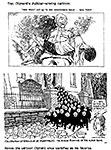
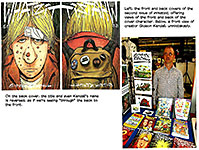
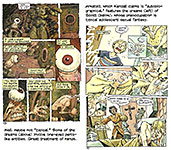
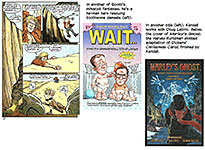
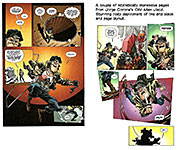
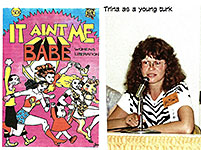

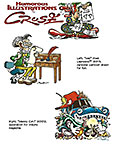
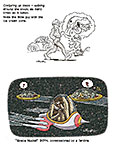
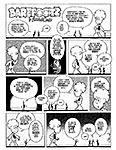
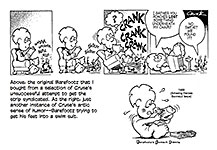
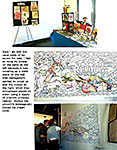

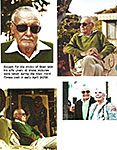
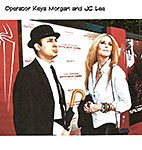
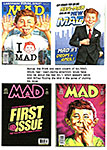
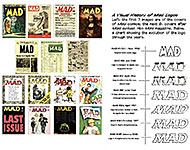
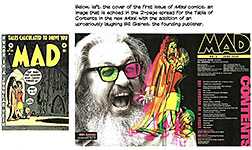
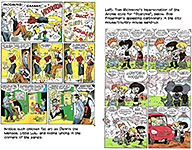
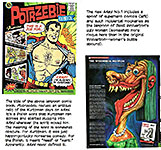
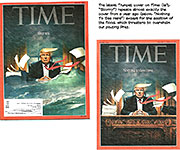
1.jpg)
2.jpg)
3.jpg)
4.jpg)
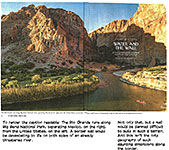
5.jpg)
6.jpg)
7.jpg)
8.jpg)
9.jpg)
10.jpg)
11.jpg)
12.jpg)
13.jpg)
14.jpg)
15.jpg)
16.jpg)
17.jpg)
18.jpg)
19.jpg)